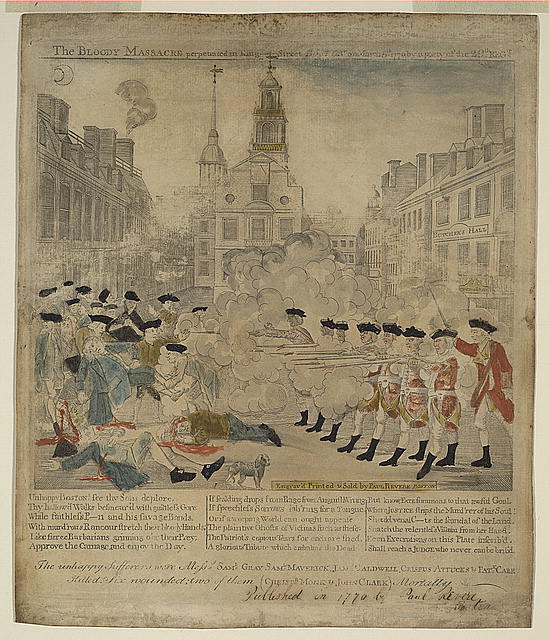
The Bloody Massacre–Or Was It?
Performance assessments require students to demonstrate what they know and can do. Often expressed as “authentic”–mostly meaning as much like the real world as possible. In this performance task, fifth graders compare three pieces of evidence from a key event in American History.
- The Paul Revere engraving of the Boston Massacre. (Above.)
- Excerpts from the “Case of Capt. Thomas Preston of the 29th Regiment.”Supplement to the Boston Evening-Post, Number 1813, 25 June 1770. (Massachusetts Historical Society)
- Excerpts from a “A Short Narrative of the Horrid Massacre in Boston.” Boston: Edes and Gill, 1770. (Massachusetts Historical Society)
The task directly addresses the following Common Core standard:
- Reading Standard for Informational Texts
Key Ideas and Details – Grade 5, Standard 6:
“Analyze multiple accounts of the same event or topic, noting important similarities and difference in the point of view they represent.”
Our objective here is to see how well students can apply knowledge and skills to make sense of documents, two of which they have not seen before. The assessment seeks to measure historical thinking and primary source analysis skills, not writing skills per se.
Focus questions and graphic organizers guide student analysis. If the class has worked with rubrics before, teachers share the task rubric with students to help them know what is expected. Questions require increasing skill. The final question requires students to move beyond the event at hand to generalize about how historians use evidence.
The task assumes that students have already studied the American Revolution. These documents come from an event that the students should be familiar with. The two written documents present a clear contrast of perspectives. So the emphasis is on students’ ability to draw out evidence and to reach conclusions.
Emerging America encourages teachers to use this assessment and rubric (by downloading the pdf – assessment at slideshare below) as long as they cite Emerging America, the Collaborative for Educational Services, and the U.S. Department of Education Teaching American History Program.
Developing the Tasks: Emerging America and Performance Assessment
In 2009-2011, anticipating assessment under the Common Core State Standards, Emerging America Teaching American History (TAH) program participants helped create, pilot, and refine tasks for Grade 5, and for high school History I and History II.
The following principles helped ensure engaging, useful, and practical assessments:
- Students will analyze and write in depth about the main source of evidence in History: primary sources.
- Tasks will be worthwhile in their own right, providing a learning experience as well as generating information about student knowledge and skills.
- Topics will be familiar, but at least one source in each task will (ideally) be new to all students.
- Sources will be accessible, including images.
- Assessments should take less than one hour.
A team of educators score each submission, using an accompanying rubric. A team of educators scored each submission, using a performance assessment rubric developed specifically for this project. A White Paper will be released in Fall 2013 with our conclusions, comparing responses from students of our program participants and students from a control group of teachers who have not participated in our program.
Featured Source
The bloody massacre perpetrated in King Street Boston on March 5th 1770 by a party of the 29th Regt. 1770. Image from the Library of Congress.
Using This Source
How does historical thinking help us to understand and interpret materials from the past?
How can we build credible knowledge based on what are often fragmentary and puzzling images, documents, and objects?
Each Featured Source models an approach to inquiry-based instruction from the Library of Congress. Emerging America guides you in exploring a sample source from the vast digital collections of the Library of Congress.
For more information about Historical Thinking please visit our
AHA Historical Thinking Benchmarks page.
Image Source:
Prints & Photographs Online Catalog, Library of Congress.



